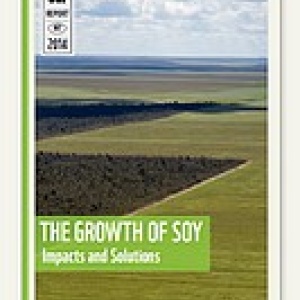WWF International has published a report on soy which looks at how soy is produced and used, which countries are at risk from the expansion of soy and at how the production of pork, poultry and dairy drive soy production. Most importantly the report discusses how the carbon footprint of soy can be reduced and how a more responsible soy industry can be created, by suggesting ways in which rising demand for soy can be met without contributing to deforestation and habitat loss.
Most of the soy produced is used as animal feed and due to a rising demand worldwide for meat products soy has now become one of the world’s major crops. The report takes a global perspective on the drivers of soy but places special emphasis on the European soy market. It also has a section which considers the biodiversity impacts of soy production in specific regions - South America in particular is a region where expansion of agricultural land for soy production has led to significant losses of natural ecosystems.
The report finds that increasing demand for soy is converting savannahs and forests into agricultural land, depleting natural ecosystems and threatening the survival of several animal species. The report also describes what we as consumers can do. As part of this it links soy production, commodity trade and financial transactions, making it possible to see who the main traders and influencers are. It includes sector specific advice for soy producers, soy traders and consumers as well as for governments in soy producing and soy consuming countries, for NGOs, for buyers in feed, meat and dairy, food processing and retail sectors and lastly specific advice for the financial institutions engaging with producers and traders.
Citation
WWF, The Growth of Soy: Impacts and Solutions, 2014, WWF International.
You can read more about this report here and to download the full report directly, use this link.
For other reports, papers and presentations on soy (including other work by WWF) see here, here and here. You will also find more information producer and consumer responsibilities here and more on land use and soy in Brazil here. To read more about carbon footprint measurement and tools here. For more information on responsible soy production and RTRS certification, browse through our resources on industry actions here.








Post a new comment »